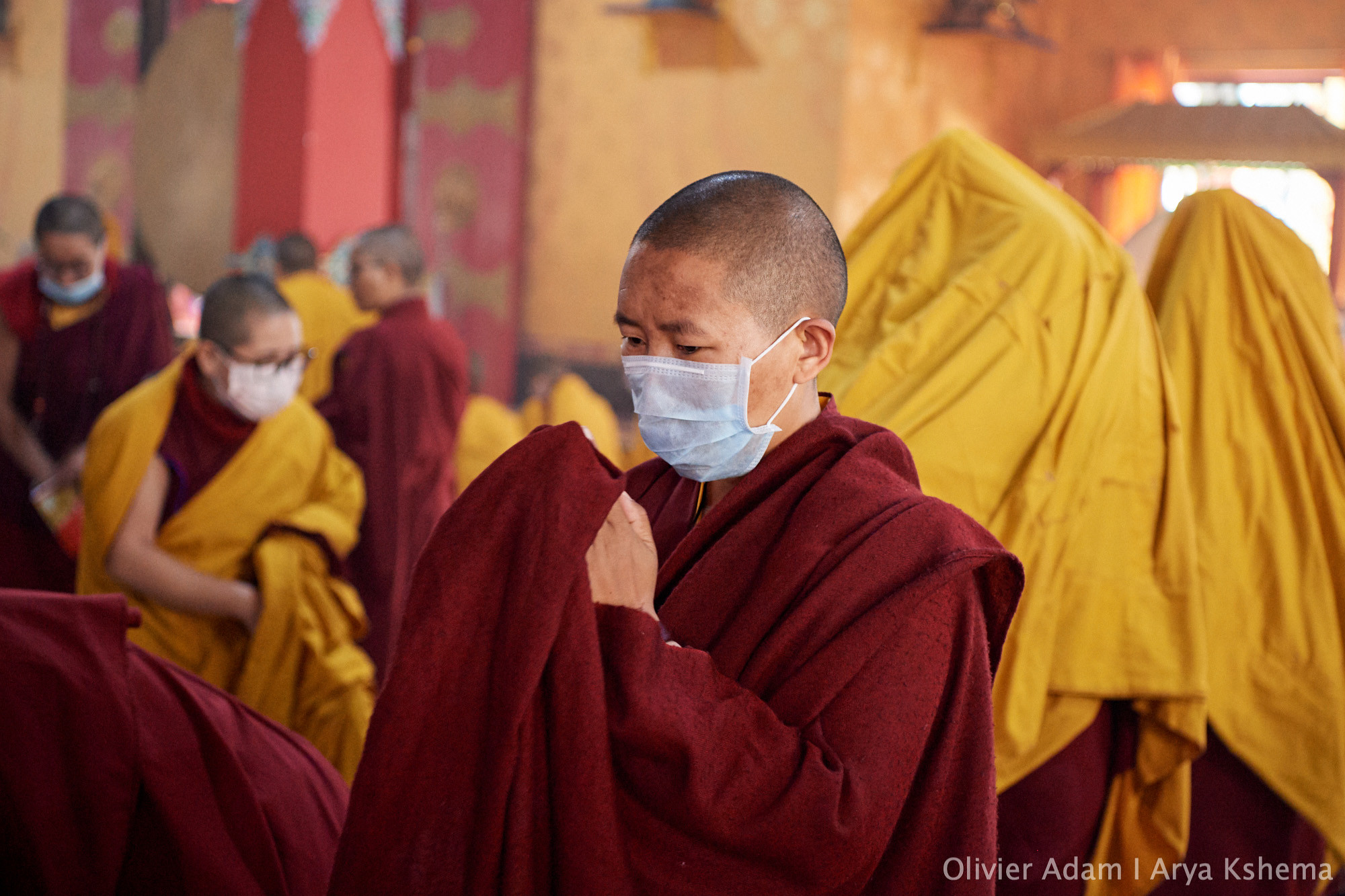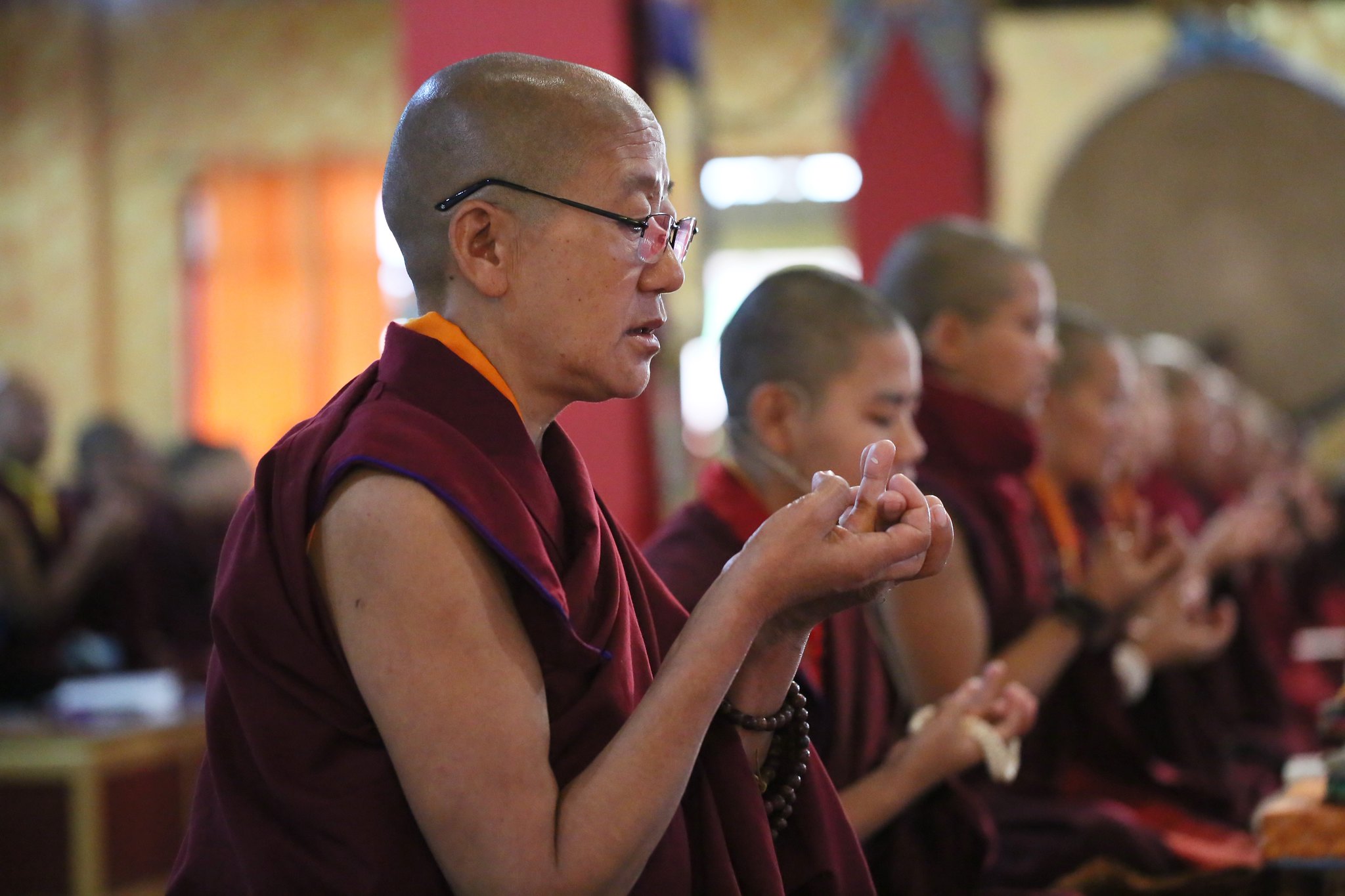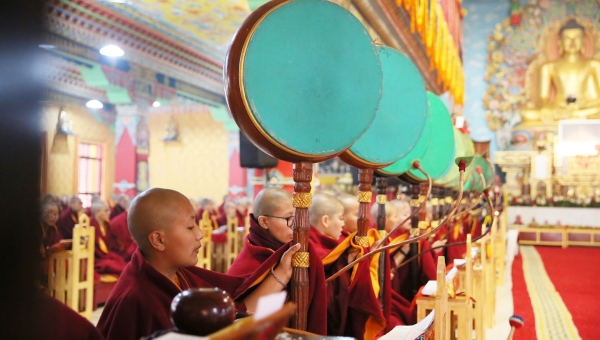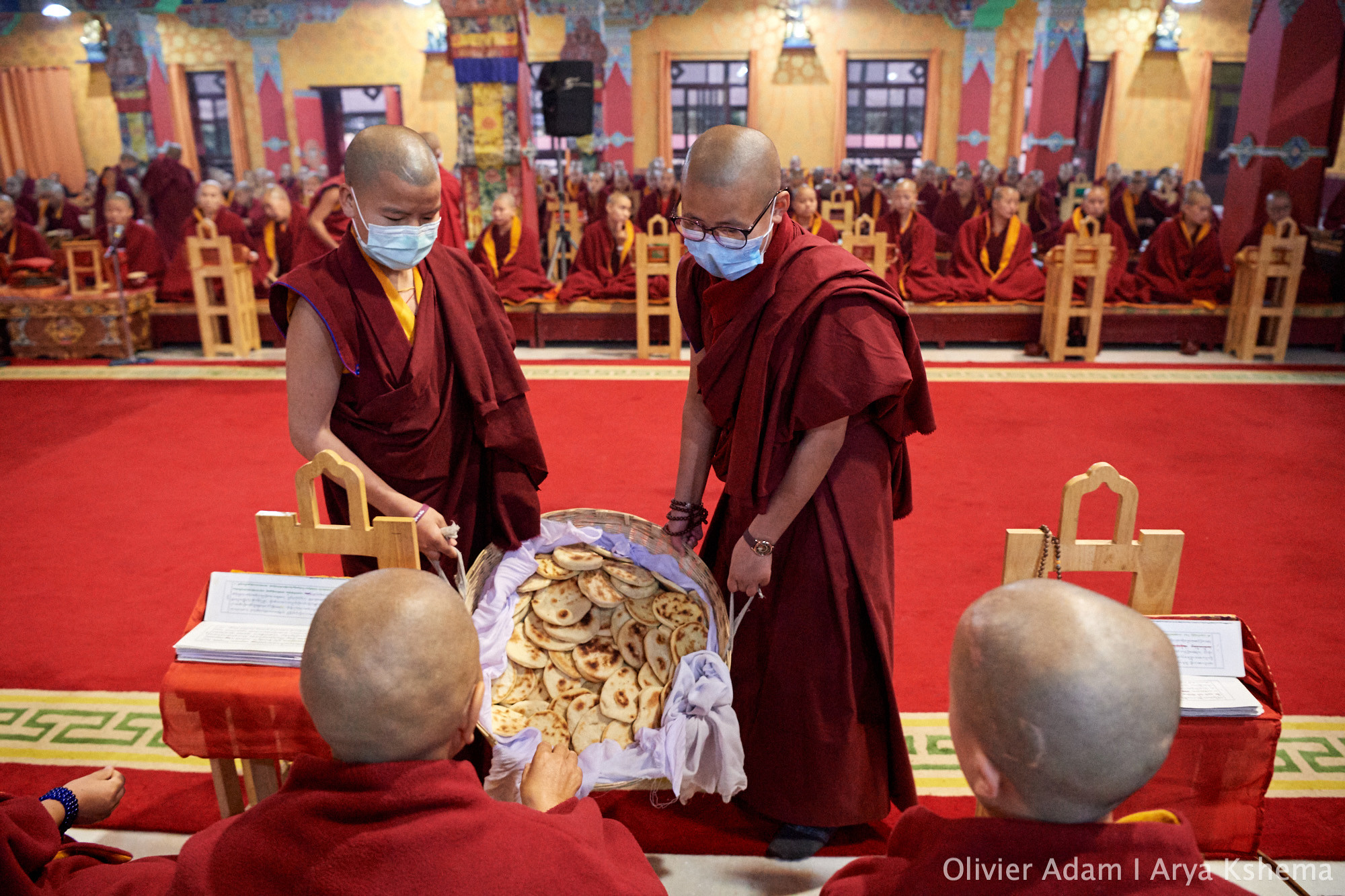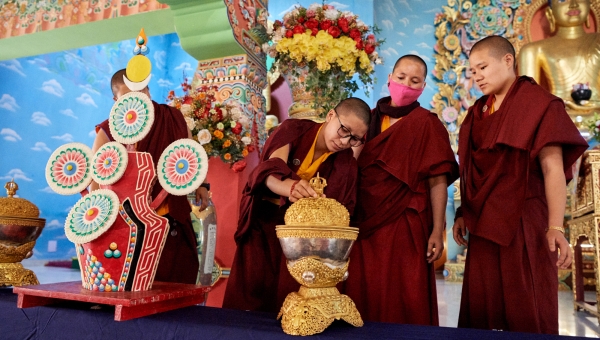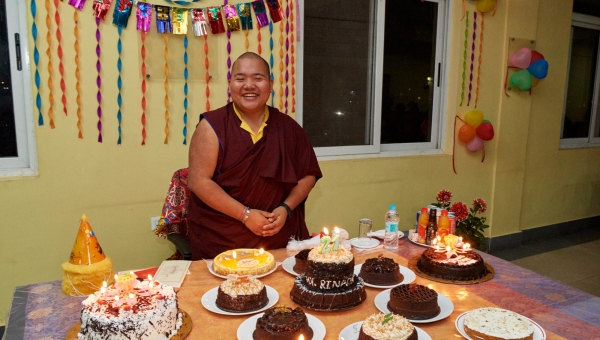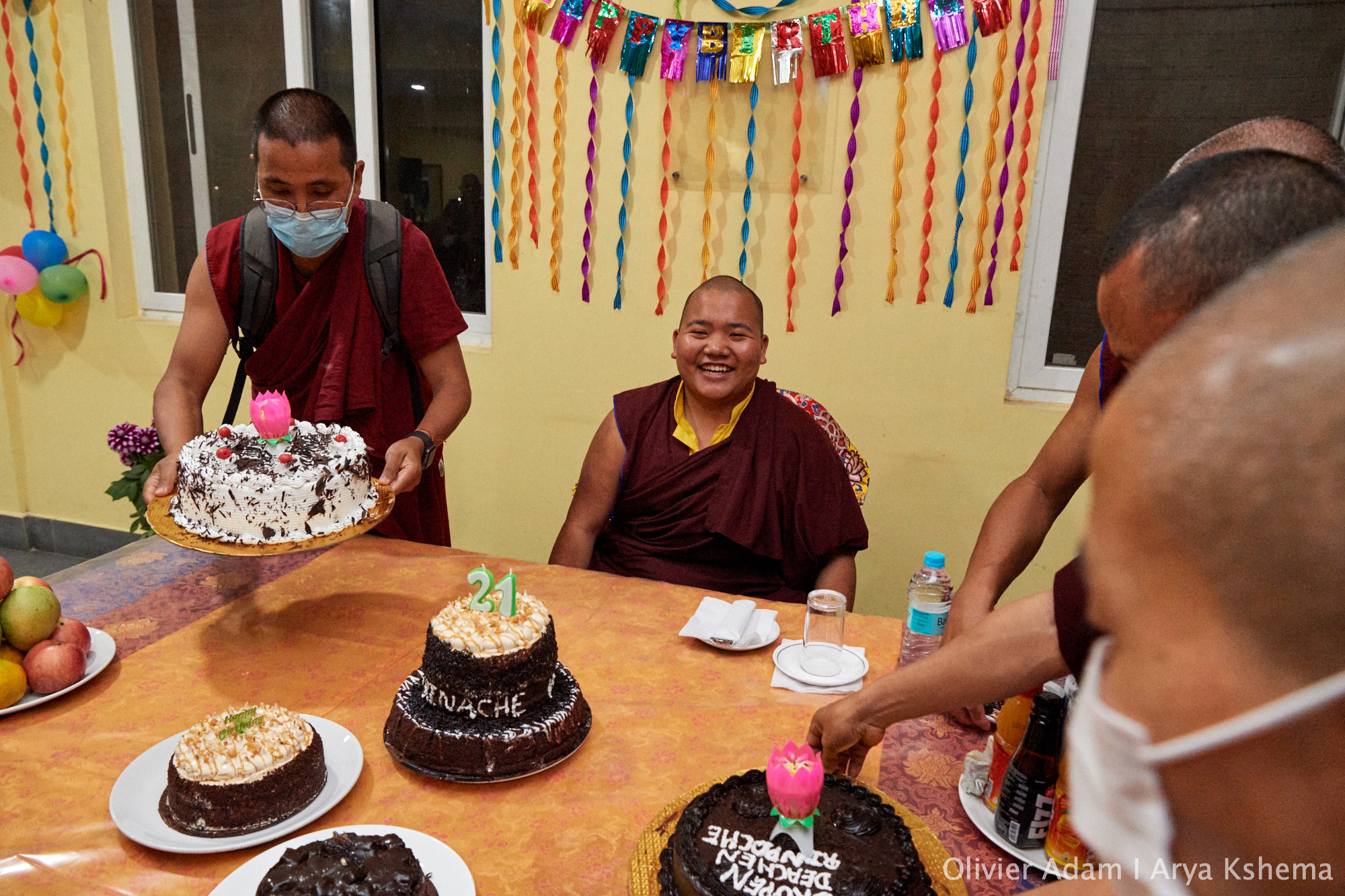The Presentation of the Six Transcendences
His Holiness the 17th Karmapa’s Teachings on Gampopa’s Ornament of Precious Liberation
Day Six
Tergar Monastery, Bodh Gaya, India
February 19, 2020
This was the last day of the teachings and time was constrained. His Holiness briefly mentioned the remaining five of the nine things to be considered when benefitting sentient beings:
5. Considering this and future lives;
6. Considering the vows and non-virtues;
7. Considering the pros and cons of giving;
8. Considering sentient beings’ separate interests;
9. Considering the pros and cons for one’s own dharma practice.
He promised to teach them in future if he had time. However, as he was basing this teaching of the nine considerations on the words of Dza Patrul Rinpoche, the Karmapa suggested that everyone should refer to that text.
He then set out to finish Chapter 11 as a reading transmission with commentary.
His Holiness read the first passage which had been reiterated throughout the teachings. It begins with the three-fold precepts of engaged bodhicitta: the higher training in discipline, higher training in samadhi, and the higher training in wisdom.As cited previously, His Holiness re-read the brief quote from the The Lamp for the Path of Awakening on these three trainings.
He noted, “I have explained these at length already. Generally, when we talk about the Buddhist three trainings, the Mahayana trainings are superior to the Foundation Vehicle trainings. Asanga’s Mahāyānasamgraha [The Compendium of the Mahayana] talks about the four ways the training in discipline is superior, the six ways the training in samadhi is superior, and the eighteen ways the training in prajna is superior.”
His Holiness read the eighteen ways the training in prajna is superior:
1. The essence of thought-free wisdom;
2. Place;
3. Basis;
4. Focus;
5. Image;
6. The response to objections;
7. Support;
8. Companions;
9. The ripening;
10. The compatible cause;
11. Deliverance;
12. Leading to the ultimate;
13. Arising from training;
14. Being thought-free;
15. The benefits of achieving;
16. The classifications;
17. The analogies for achieving;
18. The spontaneous achievement.
These are the eighteen aspects that make the Mahayana training superior to the Foundation Vehicle trainings and there were many profound things that could be said if explored in detail, but it was not necessary to elaborate further at this time, His Holiness said.
He continued reading from the Ornament of Precious Liberation:
The higher training in moral discipline consists of three: generosity, discipline, and forbearance; the higher training in mind consists of meditative concentration (dhyana); and, the higher training in wisdom consists of profound wisdom (prajna). As for diligence, it serves as a complementary factor to all three trainings. The Ornament of the Mahayana Sutras says:
The Victorious One has most perfectly explained the six perfections in terms of the three trainings: the first three are the first; the last two are the last two; while one [diligence] applies to all three.
This describes how the six transcendences are contained in all three trainings. This goes with the ascertainment of the number. In terms of the three trainings, it is the same presentation. The essence of training in discipline is discipline. Because we must practice discipline without attachment to food, clothing, and so forth, generosity can be included here. In order to practice the four spiritual trainings, we also have to have patience. Hence, generosity, discipline, and patience are all included within the training in discipline.
Three of the transcendences remain. Dhyana is the essence of the training in samadhi, and prajna is the essence of the training in prajna. Finally, there is diligence. Diligence is necessary for all three trainings. It is the crown jewel of them all. In order to perfect the three trainings, you must complete the six transcendences. And, the three trainings are the essence of practice of all six transcendences.
Reading from the text, His Holiness said,
Thus the synopsis for this chapter is the following:
Training in engaged bodhicitta can be summarized as six fold: generosity, moral discipline, forbearance, diligence, meditative concentration, and wisdom.
In the Questions of Subāhu Sutra, too, it says:
Subāhu! For the great bodhisattva to quickly achieve real and perfect enlightenment, the six perfections must be applied constantly and in all circumstances until their utter completion. What are those six? They are the perfection of generosity, the perfection of moral discipline, the perfection of forbearance, the perfection of diligence, the perfection of meditative concentration, and the perfection of wisdom.
These six transcendences should be understood in two ways through a summarized explanation, an overview treating them as a group, and as a detailed explanation of each perfection.
The six perfections are summarized through six topics: ascertaining their number, ascertaining their order, essential characteristics, etymology, subdivisions, and groupings.
His Holiness commented: This brief overview is teaching it in terms of the six points. Ascertaining their number is six. What it says in the text is:
First, ascertaining their number is six. In terms of higher states of rebirth and liberation, there are three conducive to higher rebirth and three conducive to liberation. Of the three that lead to higher states, the perfection of generosity nurtures material prosperity, the perfection of moral discipline nurtures a good physical existence, and the perfection of forbearance nurtures a favorable environment. Of the three that lead to liberation, the perfection of diligence nurtures increases of qualities, the perfection of dhyana nurtures shamatha and the perfection of prajna nurtures profound insight.
The Ornament of Mahayana Sutras states, “Higher states – the best possible prosperity, body, and retinue.”
His Holiness now commented at length. He explained that The Ornament of Mahayana Sutras teaches six different ways of ascertaining the number, but The Compendium of the Mahayana has a different way of organizing them. In this text, the ones taught in The Ornament of Mahayana Sutras are first, ascertaining in terms of the higher states, second, ascertaining the number in terms of accomplishing the two benefits, third, ascertaining the number in terms of perfecting the benefit for all others in all ways, fourth, in terms of including the entire Mahayana, fifth, in terms of completeness of aspects of the path of method, and sixth, in terms of the six methods. However, The Ornament of Precious Liberation primarily speaks about it in terms of the first way of ascertaining the number. The meaning of the six is taught above in the summary of the three trainings and has already been explained.
The text speaks of ascertaining the number in terms of the higher states. This means that a bodhisattva must practice the six transcendences: all six are necessary for achieving the higher states. If any are missing, it is impossible to achieve them. For example, if we want to have a good human rebirth in the next life, with all the facilities, good conditions, and meet a teacher, then we need to have all six of the transcendences. And these six transcendences have to be all connected. If you want to have plentiful resources of food and clothing, then you need to practice generosity. If you want to have a good body and be physically attractive, then you need to have discipline. If you want to get along with friends and family, then patience is necessary. To complete whatever action, diligence is necessary. You must have dhyana to be able to direct your focus and have control over it. To know whether your aims or actions are erroneous or not, you must have prajna. In order to achieve the excellent higher states, you must have all six. The bodhisattvas, the children of the Buddha, must have all six. That is the meaning taught here.
Now, in terms of the six in The Compendium of the Mahayana, it is taught differently. Let me just give you the terms. The three are: the antidote for the contrary factors, the basis for accomplishing the activities for achieving the qualities of a buddha, and to be able to become a precursor for ripening sentient beings. This is basically the same as the three ways that are taught in The Ornament of Mahayana Sutras. The reason why there are so many ways to ascertain the number is that as bodhisattvas need to achieve a good bodily basis in order to be able to benefit others, no matter what the size of any action they do, they are unable to do this if they lack any of the six transcendences. For that reason, it is said repeatedly, and, looked at from many perspectives, to explain it so that everyone can understand it.
His Holiness then turned to the next point. Reading from the text:
Second, the perfections occur in a definite order. First, there is the order in which they develop within the mental continuum of a person. Generosity enables proper conduct without concern for material well-being. Possessing moral discipline, forbearance can be cultivated. Through forbearance, diligence is enabled. Through diligence, meditative concentration can be developed. The mind that rests skillfully in meditative concentration will know properly the true nature of phenomena, just as it is. Alternatively, the order of sequence could be considered in terms of the gradual progression from lesser to higher. The lesser are those explained first, and those founded in what is nobler are explained subsequently. Or, the order of sequence relates to the gradual progression from the grosser to the subtler. That which is grosser is easier to engage in and is thus presented earlier, while those that are subtler, because of their being more difficult to engage in, are presented later. In this regard, The Ornament of the Mahayana Sutra says:
The latter arises on the basis of what comes before: and since some are inferior and other superior, some grosser and others subtler, they abide in their respective sequence.
His Holiness commented: Here, is the ascertainment of the order of the six transcendences – this order of earlier, later, higher and lower. The reasons are: a) the order that they arise; b) superior and inferior; and c) order of subtlety. Regarding the first, the order of arising, a basic understanding is that if you have no attachment to food, clothing, or material things, then you will be able to take vows and keep them purely. If you are able to turn away or refrain from harmful actions, then you can be patient with those who harm you. You will not get angry because you will see wrongs and refrain. You will be able to see the disadvantages of anger. If you are able to put up with suffering, then you will not be disappointed by difficulties. You will be able to put up with them and not be discouraged by difficulty and hardship. Your mind will naturally have courage and heart. If you are able to have diligence, then this is the zest to practice day and night without distraction. If you are able to do that, then it is easy to develop dhyana. If you are able to place your mind on a virtuous focus, then it is not difficult to develop the prajna that sees the nature as it is. If you have the earlier ones, you will not have difficultly developing the later ones. They will arise very easily. That is the reason why it is taught.
The next is in terms of superior and inferior. It is said that better than keeping infinite discipline in higher realms is to keep one in an impure realm. Generally, for ordinary people it is more difficult; and, it is more superior for ordinary individuals to practice discipline than giving food and clothing. And, even more difficult is refraining from killing and not getting angry when other people harm you. When you practice what is greater than that, it is diligence. Following diligence is resting the mind one-pointedly and seeing the nature of the four noble truths. That produces the full blown prajna which is superior. The later transcendences are finer than or more superior to the earlier ones.
The third is the order of subtlety. When we talk about the order of subtlety, it is not saying categorically that generosity is easier than discipline and patience is easier than diligence. But, if we think about it, it is harder to keep vows than to give food and wealth. Compared to keeping vows, when people give you a hard time, trying to be patient is even more difficult. More than being patient, being able to be diligent with regard to listening, contemplation, and meditation is more difficult. We need to have fortitude. What is even more difficult than that is developing shamata. Even more difficult than that is to know the wisdom realizing emptiness, developing the prajna of insight. For that reason, the later ones are more difficult to practise than the earlier ones. Here, grossness or subtlety refers to the ease or difficulty of mastering each of these transcendences.
The third point is the characteristics. His Holiness read from The Ornament of Precious Liberation:
The third point concerns the four essential characteristics of the bodhisattva generosity and the other perfections: 1) they diminish the strength of the unfavorable forces; 2) they enable the arising of pristine awareness, utterly free of concepts; 3) they bring perfect accomplishment of aspirations; and 4) they bring sentient beings to their full maturity in three ways [of the vehicles]. The Ornament of Mahayana Sutras says of this:
Generosity curtails unfavorable forces, brings non-conceptual pristine awareness, perfectly fulfills all wishes, and brings beings to maturity in three ways.
His Holiness explained that at this point—when talking about the characteristics, the essences of generosity and so forth in general, and, particularly the essences of transcendent generosity —there are many different types and presentations. There is the one from The Way of the Bodhisattva, those listed in the Bodhisattva Levels, and other texts such as The Compendium of the Mahayana.
The meaning as seen in The Ornament of Clear Realizations is that there are four characteristics: 1) what is discarded, 2) the antidote, 3) the function, and 4) the culmination. These are four characteristics or qualities used to teach the essence of the transcendences. His Holiness chose to use generosity to illustrate the four characteristics. First, it discards its contrary action which is stinginess; second, the antidote is that it is endowed with thought-free wisdom; third, its function is that it temporarily fulfills the wishes of others; and fourth, its culmination is that it allows us to stay in any of the three trainings. The Ornament of Precious Liberation teaches the Mahayana Vehicle and primarily talks about the culmination.
The next part concerns the etymology. Reading from the Ornament of Precious Liberation:
The fourth point relates to the etymology of the transcendences. Since it clears away suffering, it is generosity; since it is the attainment of coolness, it is moral discipline; since it copes with [what would cause] anger, it is forbearance, since it is application to that which is sublime, it is diligence; since it keeps the mind turned inward, it is dhyana; and since it knows the ultimate meaning, it is prajna. Since all of them transport one from samsara to the far shore – namely to nirvana – they are called “transcendences” or paramitas. In this regard, The Ornament of Mahayana Sutras states:
Since through them one eliminates poverty, obtains coolness, forbears wrath, connects with the supreme goal, retains the mind, and knows the ultimate, they are thus termed.
Commenting on the clause ‘eliminates poverty’, His Holiness explained that it seemed the Sanskrit word for generosity also implies ‘eliminating poverty’, but the Tibetan word (jin-pa)does not. In future, after further study of Sanskrit, he hoped to be able to explain more about the etymology of the terms in detail.
Reading from the Ornament of Precious Liberation,
The fifth point concerns the six subdivisions within each of the perfections – the generosity of generosity, the moral discipline of generosity, and so forth, thus giving rise to the thirty-six subdivisions. The Ornament of Clear Realization says:
The six-perfections, generosity, and so forth, each encompassing a six fold division, this armour-like complete means of attainment is explained exactly in terms of six sets of six.
His Holiness elaborated that this is a reference to the practices of ancient warfare. In The Ornament of Clear Realization on prajnaparamita, it talks about four types of practice – armour-like practice, engaging practice, accumulating practice, and liberating practice. Armour-like practice is similar to putting on your armour, helmet and other protective gear. The Ornament of Clear Realization teaches it in terms of the six transcendences. When you go to war, you are only well-protected in battle if you wear a full set of armour. Likewise, if you emphasize only one of the transcendences and ignore the other five, contrary factors can arise from the ones you have neglected. In order to be fully protected from all the contrary factors, you need all six aspects of each of the transcendences – the generosity of generosity, the discipline of generosity, the patience of generosity, the diligence of generosity, the dhyana of generosity, and the prajna of generosity. You must have strong armour. In the same way that the American president is protected on all sides wherever he goes. So, in this way, you have six sets of six, thirty six in total.
Returning to the Ornament of Precious Liberation:
The sixth point examines their groupings. They fall into two groups based on the two accumulations. Generosity and moral discipline belong to the accumulation of merit. Prajna belongs to the accumulation of wisdom. Forbearance, diligence, and meditative concentration belong to both. Thus The Ornament of the Mahayana Sutras says:
Generosity and moral discipline belong to the accumulation of merit, while prajna belongs to the accumulation of wisdom, and the remaining three belong to both.
This concludes the presentation of the six perfections, the eleventh chapter of the Ornament of Precious Liberation, a Wish-Fulfilling Gem of Sublime Dharma.
His Holiness commented that there are different ways of grouping the six transcendences— in terms of the two accumulations and in terms of the three trainings—which differ slightly. In this text, they are discussed in terms of the two accumulations. When they are grouped according to the three trainings, it refers to the precepts of engaged bodhicitta, which includes all six transcendences.
The sixth day’s teaching finished at this point and the Karmapa gave a personal message to the nuns of the Arya Kshema Winter Dharma Gathering, explaining how meaningful giving these teachings had been to him and his hope that the teachings would bring benefit to all the nuns. He concluded with these words of encouragement and a promise:
Up until now in this lifetime, the greatest thing I have learned from experience is that we must not lose heart. When we talk about ‘heart’ or enthusiasm, it does not come on its own automatically, nor can we borrow it from anyone else. We need to search for it through our own efforts. Whether we find it or not is not down to where we look; it is due to a difference in the person searching. So please, all of you, don’t lose heart!
In particular, this Winter Dharma Gathering for nuns is intended for all the nunneries and for all the nuns. You should serve it with the most altruistic motivation you can, and be as careful as possible to act in ways that are beneficial to all. In the future it will be the basis for benefitting the teachings in general and in particular for increasing the nuns’ listening, contemplating, study, and practice. I think we all need to work together. If we can all work together, there is no doubt it will bring benefit, helping the teachings to flourish and beings to be happy.
So do not lose heart now or in the future. I myself will not lose heart for benefitting myself and all other sentient beings until I achieve buddhahood, until I achieve enlightenment. I will do what I can so that we can all go together, and so that the teachings may flourish.
(Click on the image below to view slideshow/photo album)
